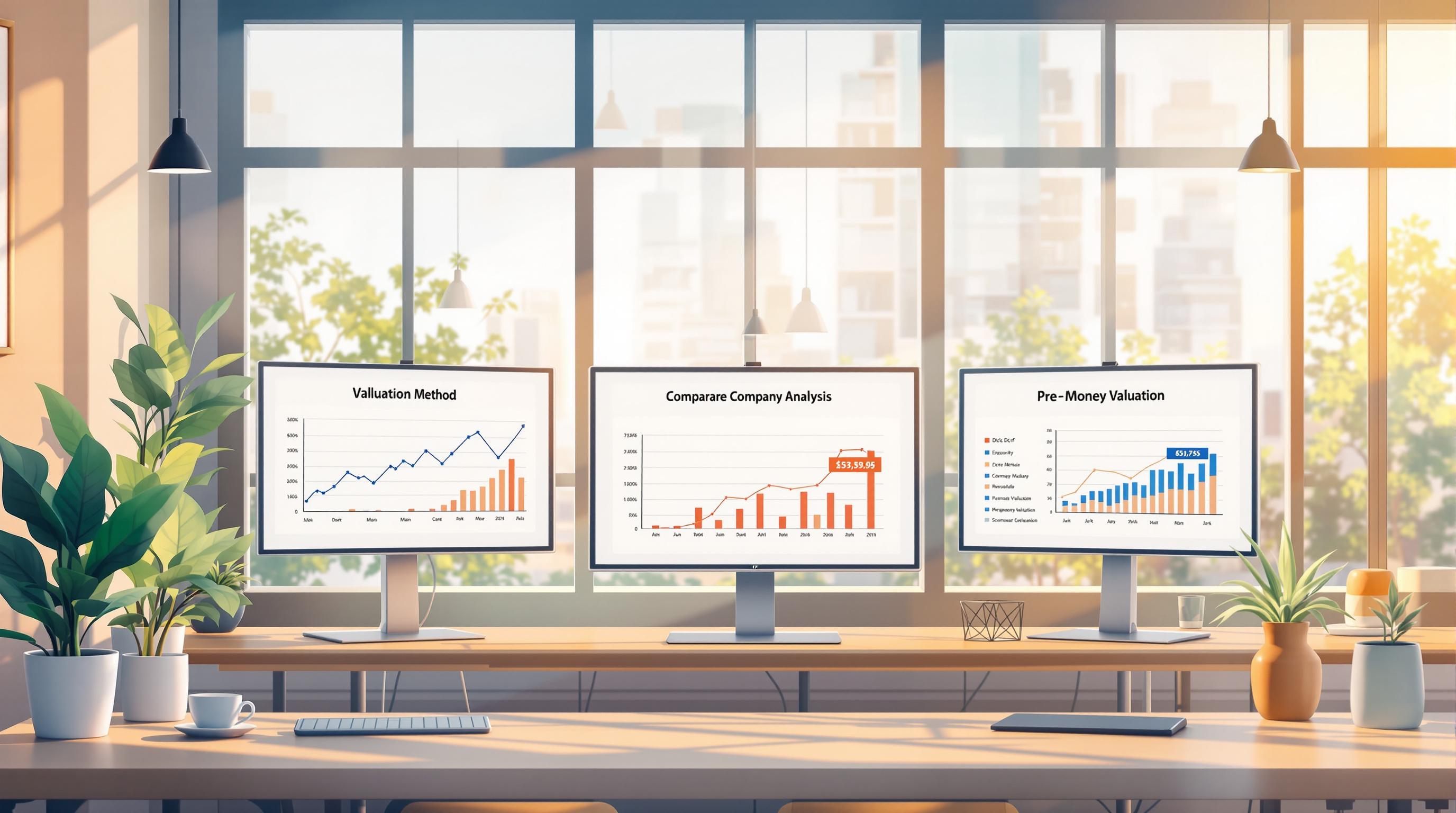Venture capital is increasingly about more than just financial returns - it's about achieving measurable societal and environmental outcomes alongside profits. By focusing on long-term impact, venture capital firms can:
- Align investments with UN Sustainable Development Goals (SDGs), targeting areas like renewable energy, healthcare, and financial inclusion.
- Achieve competitive returns: Impact-focused investments historically show 7.6% annualized returns, compared to 6.1% for traditional investments (2005–2015 data).
- Build resilience and attract better deals by focusing on startups driving meaningful change.
Key Takeaways:
- Balanced Metrics: Combine financial metrics (IRR, MOIC) with impact indicators (ESG, SDG alignment).
- Sectors to Watch: Clean energy, healthcare, education, and financial access offer strong potential for profit and purpose.
- Tools for Success: Use platforms like Carta, PitchBook, and Capital IQ to track both financial and societal outcomes.
- Diversification: Spread investments across stages, sectors, and regions to balance risk and maximize impact.
This dual focus on profit and purpose is reshaping how venture capital portfolios are built and managed, ensuring long-term success for both investors and society.
Designing and Measuring Impact Investing Portfolios
Understanding Long-Term Impact in Venture Capital
Long-term impact in venture capital combines financial returns with measurable societal and environmental outcomes. This approach aligns investment strategies with global goals, ensuring that success isn’t just financial but also contributes to broader societal progress.
Balancing Financial Returns and Broader Outcomes
Venture capital firms face the challenge of balancing profitability with purpose. This balance influences how investments are evaluated and managed:
| Investment Aspect | Financial Focus | Impact Focus |
|---|---|---|
| Return Metrics | IRR, MOIC | ESG Indicators, SDG Alignment |
| Time Horizon | 5-7 Years | 10+ Years |
| Success Measures | Exit Value, Revenue Growth | Social/Environmental Change, Sustainable Growth |
| Risk Assessment | Market Risk, Competition | Impact Risk, Social Outcomes |
Why Long-Term Impact Matters for VC Firms
This isn’t just an abstract concept - it directly affects how venture capital firms operate and compete in the market.
"Impact-focused venture funds have been gaining traction in recent years, with an increasing number of fund managers and investors recognizing the potential for startups to drive significant social and environmental change." - VC Lab, 2023 [1]
Firms that prioritize long-term impact enjoy several advantages:
- Better Access to Deals and Partnerships: These firms attract innovative startups and build strong relationships with investors who share similar values.
- Stronger Resilience: Impact-driven investments often weather economic downturns more effectively.
Industries like renewable energy and healthcare showcase how financial growth can align with societal benefits when long-term impact frameworks are applied [1]. Modern portfolio management tools also play a key role by tracking both financial and impact metrics, allowing firms to make informed decisions without losing sight of their broader objectives.
To achieve meaningful results, VC firms need reliable systems to measure and monitor their impact over time.
How to Measure Long-Term Impact in VC Portfolios
Key Metrics for Measuring Impact
Measuring impact in VC portfolios involves blending financial metrics like IRR and MOIC with indicators that highlight broader outcomes, such as job creation or alignment with the UN's Sustainable Development Goals (SDGs).
| Metric Type | Financial Indicators | Impact Indicators |
|---|---|---|
| Primary Metrics | Total Exit Value, IRR | Job Creation, Societal Impact |
| Secondary Metrics | Revenue Growth, MOIC | SDG Alignment, Social Outcomes |
| Risk Metrics | Market Volatility, Burn Rate | Impact Risk, Sustainability Score |
Using Longitudinal Studies to Track Impact
Longitudinal studies are a powerful way for VC firms to monitor the long-term outcomes of their investments. These studies provide insights into which investments deliver the most value over time and help refine future strategies. They allow firms to:
- Evaluate how portfolio companies perform against specific impact goals.
- Identify characteristics of investments that yield strong results.
- Adjust their investment approach based on data collected over extended periods.
Tools for Portfolio Analysis
Modern portfolio analysis tools have revolutionized how VC firms assess both financial performance and societal impact. Some of the most commonly used platforms include:
| Platform | Primary Function | Key Features |
|---|---|---|
| Carta | Portfolio Management | Valuations, Cap Table Management |
| PitchBook | Market Intelligence | Deal Analytics, Industry Trends |
| Capital IQ | Financial Analysis | Financial Data, Market Research |
VC firms leveraging these tools often outperform broader equity market benchmarks across various timeframes [3]. Beyond financial insights, these platforms provide essential data to evaluate the long-term societal contributions of their investments.
sbb-itb-8981daa
Sectors with Strong Long-Term Impact Potential
Venture capital has pinpointed several sectors that consistently deliver strong financial returns while addressing critical global issues. Many of these align with the United Nations Sustainable Development Goals (SDGs), offering opportunities for both profit and positive societal impact.
Technology and Clean Energy
Investments in clean energy are gaining traction, driven by global demand for sustainable solutions. Here's a closer look at key areas:
| Technology Area | Focus Areas | Growth Drivers |
|---|---|---|
| Renewable Energy & Storage | Lowering Carbon Emissions, Grid Stability | Government Policies, Infrastructure Development |
| Smart Buildings | Energy Efficiency | Urban Growth, Climate Regulations |
These technologies are reshaping how energy is produced and consumed, making them a strong fit for VC portfolios with long-term goals.
Healthcare and Education
Advancements in healthcare and education technology are transforming access and efficiency in these sectors. Tools like telemedicine, digital health platforms, and medical technology are improving patient outcomes while lowering costs. Similarly, education tech is bridging learning gaps, providing scalable solutions for underserved populations. These innovations are not only profitable but also address pressing societal needs.
Financial Access and Agriculture
Financial inclusion and sustainable agriculture are two other areas where venture capital can drive meaningful change alongside financial growth.
| Sector | Focus Areas | Key Innovations |
|---|---|---|
| Financial Technology | Digital Banking, Microfinance | Mobile Payment Solutions |
| Agricultural Tech | Precision Agriculture, Food Security | Sustainable Farming Practices |
| Supply Chain | Reducing Waste, Distribution Efficiency | Blockchain for Transparency |
Research from Cambridge Associates highlights that impact-focused investments in these sectors have delivered an average annualized return of 76.1% over the past two decades [3]. This performance underscores the potential for investors to achieve strong financial outcomes while addressing global challenges.
These sectors offer a roadmap for aligning investment strategies with broader, long-term objectives, setting the stage for effective portfolio planning.
Steps to Include Long-Term Impact in Portfolio Planning
Diversifying Investments for Stability
Building a well-rounded portfolio involves spreading investments across different sectors, stages, and regions. This approach not only balances financial returns but also addresses broader societal goals. According to Cambridge Associates, venture capital portfolios with diverse investments tend to perform better over time, reducing risks while unlocking opportunities [3]. To achieve this, consider including a mix of high-growth sectors, early and late-stage investments, and regional opportunities that cater to varying market demands.
Using Data to Guide Decisions
Data plays a crucial role in shaping modern investment strategies. With the global impact investing market hitting $1.4 trillion in assets under management in 2022 [1], it’s clear that data-driven approaches are becoming essential.
Portfolio managers should focus on key metrics such as internal rate of return (IRR), multiple on invested capital (MOIC), ESG compliance, alignment with Sustainable Development Goals (SDGs), and measurable market reach. These metrics not only help gauge financial success but also ensure that societal objectives are being met. By relying on these insights, firms can align their investments with both financial and impact-driven goals, creating a roadmap for long-term success.
Advanced analytics tools also enable firms to connect more effectively with like-minded investors and founders who share their vision for the future.
How VC Investor List Can Help Founders

Founders looking to align their ventures with long-term impact goals can benefit from external resources like VC Investor List. This platform offers tools to:
- Find investors focused on specific impact-driven sectors.
- Review investor track records in areas like impact investing.
- Identify firms with shared values and a forward-looking approach.
- Connect with investors across different stages and funding sizes.
VC Investor List bridges the gap between founders and investors in industries such as technology, healthcare, and fintech, helping align business goals with measurable growth and meaningful societal outcomes.
Conclusion: Balancing Profit and Purpose in VC Portfolios
Incorporating long-term impact strategies into venture capital portfolios has become a key approach for achieving lasting success in today’s investment landscape. By prioritizing both financial gains and societal benefits, VC firms can create portfolios that are not just profitable but also resilient over time. These strategies provide a clear path for aligning investments with broader impact goals.
Venture funds focused on impact have shown that profit and purpose can work together, especially when targeting sectors that address global challenges. This dual focus allows firms to stand out while delivering meaningful results across various areas.
To succeed, impact strategies often center on sectors like renewable energy, healthcare, and education. They also rely on strong measurement tools, data-driven decisions, and diversified investments across different stages and regions.
Portfolio management today blends ESG considerations with traditional financial metrics. This shift reflects the growing recognition that long-term success depends on addressing the needs of multiple stakeholders while maintaining solid financial outcomes.
Technology has become essential in this space, with tools designed to track both financial performance and impact metrics. Platforms like VC Investor List also play a role by connecting purpose-driven founders with aligned investors, simplifying the process of building impact-focused portfolios.
The future of venture capital lies in this thoughtful combination of profit and purpose. Adopting long-term impact strategies not only helps firms navigate risks but also positions them to capitalize on emerging opportunities while contributing to global development goals. This approach builds portfolios that deliver both strong returns and meaningful societal benefits.
FAQs
How do VC companies monitor their investment?
Venture capital firms keep tabs on their investments by analyzing key financial metrics and using specialized tools. Two primary metrics are Internal Rate of Return (IRR), which measures annualized profitability, and Multiple on Invested Capital (MOIC), which shows growth compared to the initial investment.
To streamline tracking, firms rely on tools like Carta, PitchBook, and Capital IQ. These platforms offer real-time insights into portfolio performance and market trends [4][5]. While these metrics provide a snapshot of performance, tracking outcomes over time through longitudinal studies adds a deeper layer of understanding.
How do longitudinal studies enhance portfolio monitoring?
Longitudinal studies follow portfolio performance over an extended period. They reveal patterns in growth, market changes, and broader societal results [2]. This approach helps refine investment strategies and assess outcomes over the long term. It's especially useful in industries where the impact unfolds gradually.
What sectors show promising long-term impact potential?
Some industries offer a mix of financial growth and societal benefits, making them attractive for venture capitalists looking to achieve both profit and purpose.
| Sector | Focus Areas | Key Drivers |
|---|---|---|
| Clean Energy | Carbon reduction, sustainability | Government policies, market demand |
| Healthcare | Access to care, medical innovation | Aging population, tech advancement |
| Education | Learning accessibility, skills development | Digital transformation |
| Financial Access | Economic inclusion | Digital banking, blockchain |
How can founders find impact-focused investors?
Platforms like VC Investor List connect founders with investors who prioritize societal and environmental impact. This directory spans various sectors and stages, making it easier for startups to find the right investment partners.
What role does diversification play in impact investing?
Diversification is key to balancing risk and achieving impact goals. By spreading investments across different industries, stages, and regions, investors can reduce risk while aiming for both financial returns and societal benefits. A well-diversified portfolio ensures resilience and alignment with long-term objectives.


